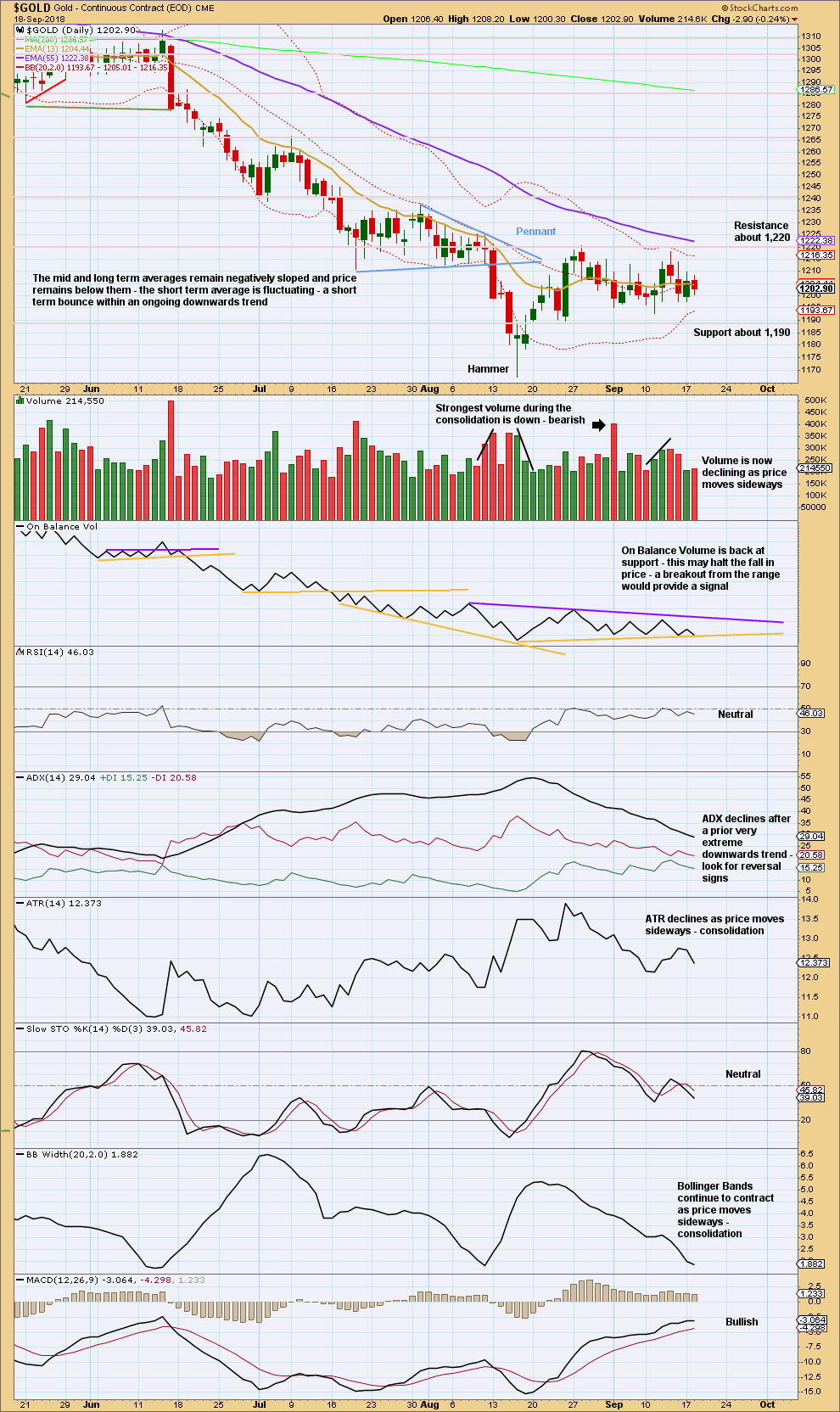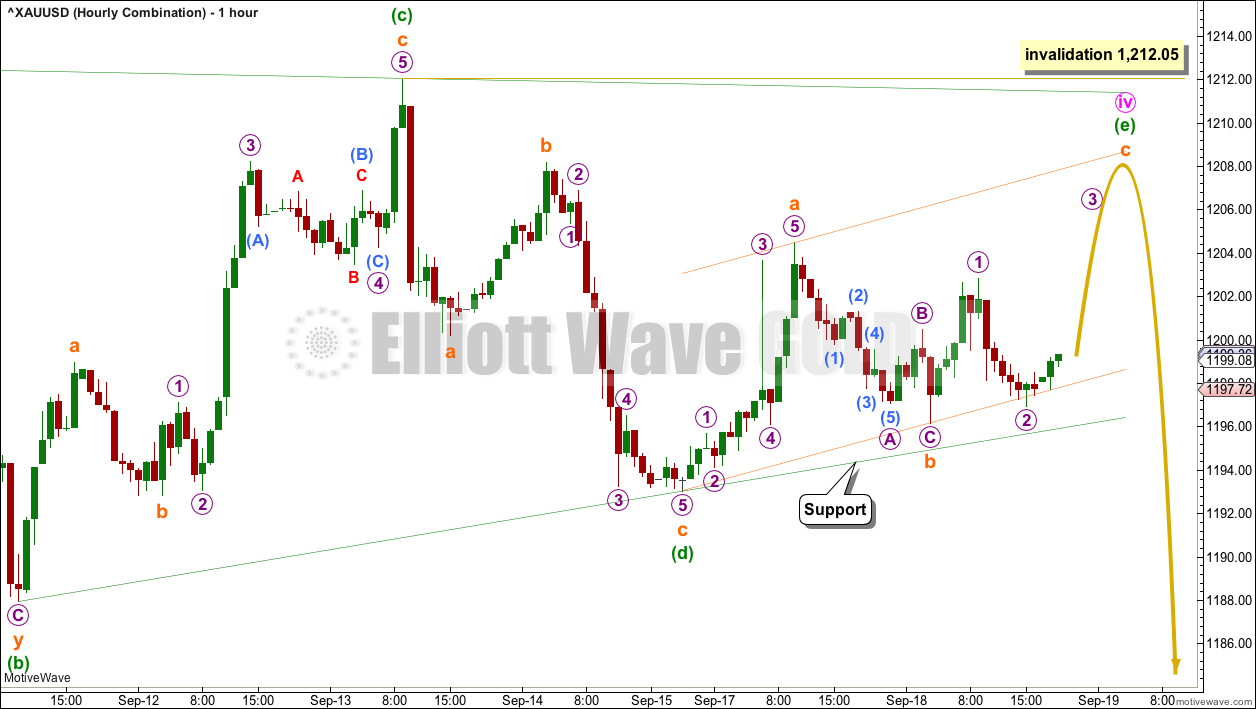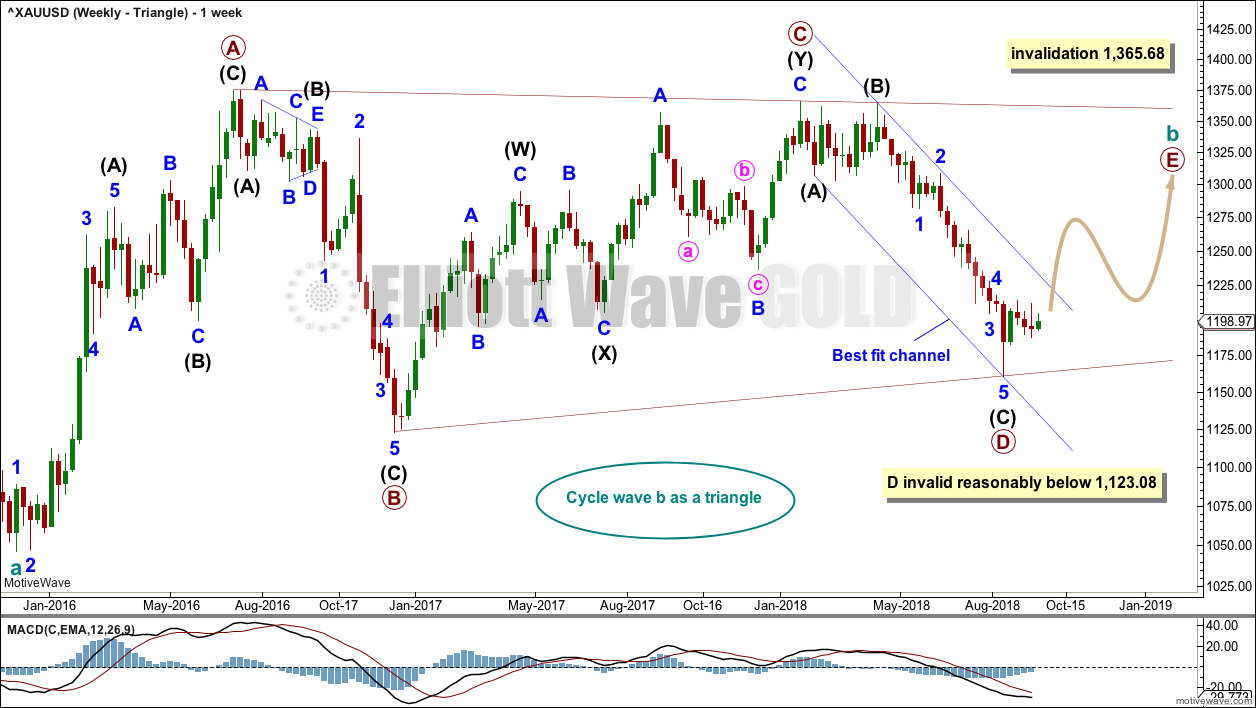A small doji candlestick continues sideways movement.
The expected direction for the breakout from this small consolidation is still the same.
Summary: A small Elliott wave triangle looks like it may be very close to completion now for Gold. Look out for a downwards breakout. If price breaks below the lower edge of the triangle trend line, then the downwards breakout may be imminent.
The target for Gold is now at 1,132.
The last two bounces for GDX have relieved extreme oversold conditions. There is again room for price to fall. However, for GDX there is a short term bullish volume profile.
New updates to this analysis are in bold.
Grand SuperCycle analysis is here.
Last historic analysis with monthly charts and several weekly alternates is here. Video is here.
Weekly charts were reviewed at the end of last week here. Video is here.
MAIN ELLIOTT WAVE COUNT
WEEKLY CHART – COMBINATION
There are four remaining weekly wave counts at this time for cycle wave b: a triangle, flat, combination or double zigzag.
All four weekly wave counts were again considered at the end of last week. Only two shall be followed on a daily basis.
At this stage, this wave count may have a slightly higher probability than the other three weekly wave counts because it has more support from classic technical analysis.
If cycle wave b is a combination, then the first structure in a double may be a complete zigzag labelled primary wave W.
The double may be joined by a three in the opposite direction, a zigzag labelled primary wave X.
The second structure in the double may be a flat correction labelled primary wave Y. My research on Gold so far has found that the most common two structures in a double combination are one zigzag and one flat correction. I have found only one instance where a triangle unfolded for wave Y. The most likely structure for wave Y would be a flat correction by a very wide margin, so that is what this wave count shall expect.
Within a flat correction for primary wave Y, the current downwards wave of intermediate wave (B) may be a single or multiple zigzag; for now it shall be labelled as a single. Intermediate wave (B) must retrace a minimum 0.9 length of intermediate wave (A) at 1,147.34. Intermediate wave (B) may move beyond the start of intermediate wave (A) as in an expanded flat.
Because the minimum requirement for intermediate wave (B) is not yet met, this wave count requires that minute wave v of minor wave C of intermediate wave (B) continues lower. This is the most immediately bearish of all four weekly wave counts.
When intermediate wave (B) is complete, then intermediate wave (C) would be expected to make at least a slight new high above the end of intermediate wave (A) at 1,365.68 to avoid a truncation. Primary wave Y would be most likely to end about the same level as primary wave W at 1,374.91, so that the whole structure takes up time and moves price sideways, as that is the purpose of double combinations.
While double combinations are very common, triples are extremely rare. I have found no examples of triple combinations for Gold at daily chart time frames or higher back to 1976. When the second structure in a double is complete, then it is extremely likely (almost certain) that the whole correction is over.
DAILY CHART – COMBINATION
Intermediate wave (B) may be unfolding lower as either a single or double zigzag. At this stage, a single zigzag will be considered; the expected direction nor minimum requirement at 1,147.34 do not differ from a double zigzag.
If intermediate wave (B) is unfolding as a single zigzag, then within it minor wave C must subdivide as a five wave impulse.
It now looks most likely that minute wave iv may be continuing sideways as a triangle, although this may morph into a double combination. When a complete structure can be seen for minute wave iv, then a downwards breakout to new lows would be expected. When minute wave iv may again be seen as complete, then a target may be calculated for minute wave v to end.
HOURLY CHART
Minute wave iv is now labelled as a possible incomplete regular contracting triangle.
All triangle sub-waves may now be complete except for minuette wave (e).
The final small zigzag for minuette wave (e) is taking a little longer than expected, but the end may now be very close. The most common point for minuette wave (e) to end would be reasonably short of the (a)-(c) trend line.
Triangles normally adhere very well to their trend lines, and the triangle sub-waves commonly test the trend lines. If subminuette wave b moves lower, then it should find very strong support at the lower (b)-(d) triangle trend line. So far it remains well contained within the larger green triangle trend lines.
A breach of the lower triangle trend line would be a strong indication that the triangle for minute wave iv is over and price is on its way towards a downwards breakout.
WEEKLY CHART – TRIANGLE
The triangle so far has the best fit and look, but at this stage it no longer has good support from classic technical analysis. It is now judged to have a slightly lower probability than the combination wave count.
Cycle wave b may be an incomplete triangle. The triangle may be a contracting or barrier triangle, with a contracting triangle looking much more likely because the A-C trend line does not have a strong slope. A contracting triangle could see the B-D trend line have a stronger slope, so that the triangle trend lines converge at a reasonable rate. A barrier triangle would have a B-D trend line that would be essentially flat, and the triangle trend lines would barely converge.
Within a contracting triangle, primary wave D may not move beyond the end of primary wave B below 1,123.08. Within a barrier triangle, primary wave D may end about the same level as primary wave B at 1,123.08, so that the B-D trend line is essentially flat. Only a new low reasonably below 1,123.08 would invalidate the triangle.
Within both a contracting and barrier triangle, primary wave E may not move beyond the end of primary wave C above 1,365.68.
Four of the five sub-waves of a triangle must be zigzags, with only one sub-wave allowed to be a multiple zigzag. Primary wave C is the most common sub-wave to subdivide as a multiple, and this is how primary wave C for this example fits best.
Primary wave D must be a single structure, most likely a zigzag.
There are no problems in terms of subdivisions or rare structures for this wave count. It has an excellent fit and so far a typical look.
A channel is drawn on all charts about the downwards wave of primary wave D. Here, it is labelled a best fit channel. If this channel is breached by upwards movement, that may provide reasonable confidence in this weekly triangle wave count and the double zigzag count, and put serious doubt on the combination and flat wave counts.
This wave count now expects a consolidation for primary wave E to back test resistance at prior support, and then a significant new downwards wave for cycle wave C. For the long term, this is the most bearish wave count.
DAILY CHART – TRIANGLE
Primary wave D may again be complete. For Barchart data, there is a Morning Doji Star candlestick reversal pattern at the low.
For confidence, this wave count now requires a breach of the upper edge of the blue best fit channel. This channel is drawn the same way on all weekly and daily charts, all on a semi-log scale.
Minor wave 1 may have been over on the 22nd of August.
Minor wave 2 may be an incomplete double combination: zigzag – X – flat. Minute wave y may be an incomplete regular flat correction. Regular flats usually fit neatly into a trend channel, which is drawn about minute wave y here on the daily chart.
A target for primary wave E is the strong zone of resistance about 1,305 to 1,310. Primary wave E is most likely to subdivide as a zigzag (although it may also subdivide as a triangle to create a rare nine wave triangle), and it should last at least a Fibonacci 13 weeks. Primary wave E may not move beyond the end of primary wave C above 1,365.68.
HOURLY CHART
Minor wave 2 may be completing as a double combination.
Copy the channel over from the daily chart.
Within the double combination, minute wave w may have been a quick zigzag. The second structure in the double, minute wave y, may be an incomplete regular flat correction.
Within the flat correction of minute wave y, minuette wave (b) has met the minimum 0.9 length of minuette wave (a). Minuette wave (b) is longer than 0.9 times the length of minuette wave (a) but less than 1.05 times the length of minuette wave (a), indicating a regular flat correction. Regular flats normally fit neatly within trend channels, so look for support about the lower edge of this channel. The most common Fibonacci ratio for minuette wave (c) within a regular flat would be equality in length with minuette wave (a).
A five wave structure downwards for minuette wave (c) would be extremely likely to make at least a slight new low below the end of minuette wave (a) at 1,189.80 to avoid a truncation.
Minuette wave (c) cannot now be an impulse. It may be completing as an ending expanding diagonal, and within the diagonal subminuette wave v must be longer than subminuette wave iii to meet rules regarding wave lengths for expanding diagonals, so it must end below 1,189.34. The target remains the same and would see this rule met.
Upwards movement within Tuesday’s session now has a small overshoot of the upper ii-iv diagonal trend line. Diagonals, like triangles, normally adhere very well to their trend lines. Some small overshoots are reasonably acceptable, but a breach of the upper trend line would not be acceptable. The probability of this wave count at the hourly chart level is today reduced.
Minor wave 2 may not move beyond the start of minor wave 1 below 1,160.75.
DAILY CHART – TRIANGLE – ALTERNATE
This wave count is identical to the daily triangle wave count above, up to the end of minor wave 2 within intermediate wave (C). Thereafter, it considers the possibility that a triangle within intermediate wave (C) may currently be completing for minor wave 4.
Gold often exhibits surprisingly short and brief fifth waves out of its fourth wave triangles. This wave count would expect a triangle to come to a quick conclusion and then to be followed by a very short wave for minor wave 5, which may move only slightly below the end of minor wave 3 at 1,160.75 to avoid a truncation.
TECHNICAL ANALYSIS
WEEKLY CHART

Click chart to enlarge. Chart courtesy of StockCharts.com.
On Balance Volume is lower than its prior point at the end of November 2015. This divergence is extremely bearish but does not rule out a consolidation unfolding here; the divergence does strongly support the Triangle wave count, which expects a consolidation or bounce up to test resistance now and then a continuation of a major bear market. It could also support the flat wave count that allows for a new low below 1,046.27 in coming months.
On Balance Volume has made another new low, but price has not. There is now double bearish divergence between price and On Balance Volume.
When Gold has a strong trend, ADX may remain very extreme for long periods of time and RSI can move more deeply into oversold. However, most recent lows since November 2015 were all found when RSI just reached oversold, so some caution here in looking out for a possible consolidation or trend change would be reasonable.
Last week completes an outside week with the balance of volume upwards. Upwards movement within the week has support from volume. The long legged doji candlestick represents indecision; this is typical during a consolidation.
If price does continue lower, then look for next support about 1,140.
DAILY CHART

Click chart to enlarge. Chart courtesy of StockCharts.com.
Gold is now range bound. Resistance and support are identified on the chart. It is a downwards day that has strongest volume during this small range bound movement so far, suggesting a downwards breakout may be more likely than upwards. This technique does not always work, but it does work more often than it fails.
On Balance Volume remains range bound, and the trend lines are converging. On Balance Volume will give a signal; if it does so prior to price breaking out, then a direction would be indicated.
GDX WEEKLY CHART

Click chart to enlarge. Chart courtesy of StockCharts.com.
GDX is now moving lower exactly as expected.
After a breakout, a technical principle is the longer that price consolidates sideways the longer the resulting trend may be expected to be. Also, the longer that price meanders sideways the more energy may be released after a breakout. This is what is happening now for GDX.
A target for this downwards trend to end calculated using the measured rule is at 16.02. That is not yet met. The last gap lower was used to calculate a new target at 17.37 for the short term, which has been met. The gap remains open and so far is providing resistance.
At the weekly chart level, there is a clear downwards breakout with a breakaway gap. As breakaway gaps should not be closed, they may be used to set stops that may be set just above a downwards breakaway gap.
The bullish divergence between price and On Balance Volume noted with green trend lines is also not a strong signal. On Balance Volume is a leading indicator; when it leads, it offers a signal, but it does not always lead price.
There is short term bullish divergence between price and Stochastics. A consolidation may develop here to relieve extreme conditions.
An outside week closes green with the balance of volume upwards. The consolidation has some support from volume at this stage. A long legged doji is typical during a consolidation.
GDX DAILY CHART

Click chart to enlarge. Chart courtesy of StockCharts.com.
GDX has now closed below support on a strong downwards day with support from volume. New lows are the lowest for GDX since December 2016. This is extremely significant for GDX.
GDX is in a downwards trend. Bounces and consolidations may be used as opportunities to join the trend.
The measuring gap at 19.74 – 19.45 provided resistance, this may continue to provide resistance for any future bounces or consolidations.
If the last measuring gap is closed, then it may be relabelled an exhaustion gap. It still remains just open today. Then look for resistance next at 19.74. If resistance here is overcome, then a much deeper and longer lasting bounce may take price back up to very strong resistance at 20.80. If that happens, use it as an opportunity for another short entry; it may be a typical throwback to resistance after the strong downwards breakout.
The last two bounces have relieved extreme oversold conditions. There is now again room for price to fall.
Published @ 08:35 p.m. EST.
—
Careful risk management protects your trading account(s).
Follow my two Golden Rules:
1. Always trade with stops.
2. Risk only 1-5% of equity on any one trade.








It is possible that the small triangle on the hourly chart could now be over.
Look out for a downwards breakout. The first indication that may be happening would be a breach of the lower green triangle trend line. So watch that line carefully.
Be aware though that fifth waves out of fourth wave EW triangles can be surprisingly brief in time and short in price. Not always, but often.